A lightweight, waterproof backpack. Ideal for alpine mountaineering, rock climbing, and winter climbing.
As a full time Mountaineering Instructor, I naturally put gear to the test each day at work. I’ve spent this winter using the Deuter Durascent 30 as my go-to backpack for work and play in the mountains. I’ve had good opportunities to put this pack through its paces on days out mountaineering and climbing. I’ve got some great details to share with you, that hopefully will give you a sound insight to the performance of this technical pack from Deuter.
I need a mountaineering pack that’s tough, light, waterproof, and has just the right amount of tools needed for the job. A lot to ask for, but the major requirement for me is water resistance. If I had a pound for everytime I’ve pulled damp and soggy spare clothes, first aid kits, and ropes out of previous backpacks from water leaking through, I’d be a wealthy climber boy. The Durascent is the first waterproof backpack I’ve had that is actually waterproof, and keeps everything I need for a wet or snowy day out in the mountains dry. Finally!
Furthermore, It has all the bells and whistles you need for attaching poles, axes, helmets etc while also being minimalist. It has just the right amount of gear attachments without going overboard like most backpacks on the market. It’s light, comfortable, functional and sexy. But it can’t all be sunshine and glory for the Deuter Durascent 30, so let’s dive into more detail and see how each feature of the pack has performed over the last few months.
Deuter Durascent 30 Backpack: The stats
| Best for: | Ice climbing, mountaineering and winter climbing |
| Weight: | 730g / 1.6 lbs |
| Waterproof: | Yes |
| Hydration compatible: | No |
| Material: | 220D Polyamide |
| Eco-conscious: | PFC free |
| Overall rating: |
Features of the Deuter Durascent 30 Backpack
Alpine back system
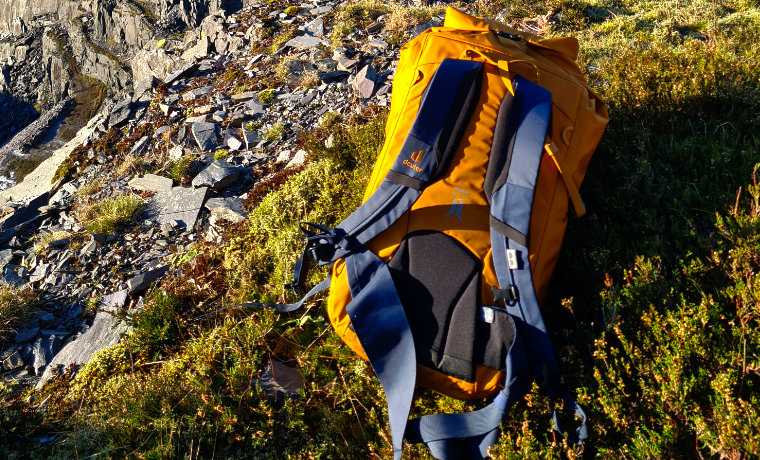 Comfortable and functional. The alpine back system works well with medium to heavy loads and spreads the weight over your back evenly. I find it doesn’t restrict movement while climbing, swinging an axe, or walking on long approaches. The soft strip back pads are comfortable on the back, and the ventilation shaft down the middle seems to work well for wicking body moisture away. It does seem basic and regressive in design in comparison to the modern ventilation systems on the market today, but the simple ventilation system seems to work pretty well and doesn’t create a “sticky back”.
Comfortable and functional. The alpine back system works well with medium to heavy loads and spreads the weight over your back evenly. I find it doesn’t restrict movement while climbing, swinging an axe, or walking on long approaches. The soft strip back pads are comfortable on the back, and the ventilation shaft down the middle seems to work well for wicking body moisture away. It does seem basic and regressive in design in comparison to the modern ventilation systems on the market today, but the simple ventilation system seems to work pretty well and doesn’t create a “sticky back”.
When climbing, it is super flexible and molds really well to the shape of my back. Balance and position of a pack is vital when climbing with a pack on, and Deuter has hit the nail on the head with this one.
The waist straps are thin and wide, ideal for spreading the weight and carrying heavy loads. The wide waist straps spread the load like a high quality climbing harness and don’t create any obvious rubbing points. The waist straps can also be tucked away behind the rear flap at the back. This is quick and easy, unlike other backpacks that are just not worth the hassle using their removable waist strap system.
Shoulder straps and sternum strap
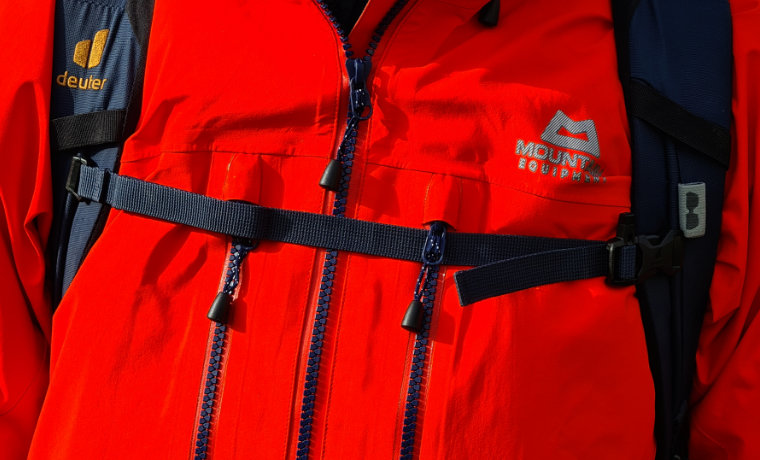 Like with most features with this backpack, the design of the shoulder straps are trimmed down to just the essentials. Despite the lack of padding, the shoulder straps are comfortable, even when carrying heavier loads. The chest buckle has the obligatory rescue whistle, a fantastic feature of most modern backpacks. Hats off to whoever came up with that design! The excess tail on the chest strap is too long, and when it’s windy it’s long enough to hit you in your eyes! The shoulder strap tails are the same; they are long enough to hit you in your face when it’s blowing a hooley outside. The chest strap buckle feels too small and flimsy at first, especially with thick gloves on. But once you get used to it, it works just fine.
Like with most features with this backpack, the design of the shoulder straps are trimmed down to just the essentials. Despite the lack of padding, the shoulder straps are comfortable, even when carrying heavier loads. The chest buckle has the obligatory rescue whistle, a fantastic feature of most modern backpacks. Hats off to whoever came up with that design! The excess tail on the chest strap is too long, and when it’s windy it’s long enough to hit you in your eyes! The shoulder strap tails are the same; they are long enough to hit you in your face when it’s blowing a hooley outside. The chest strap buckle feels too small and flimsy at first, especially with thick gloves on. But once you get used to it, it works just fine.
Roll top opening and rope straps
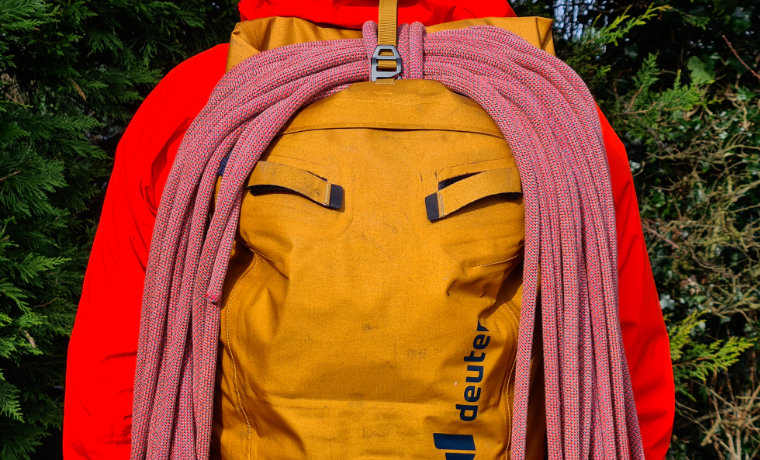 The roll top opening is one of my favorite features on the backback. It’s the least sexy part of the backpack when it comes to looks, but it definitely does its job well. It keeps the inside watertight. If you’ve slightly overloaded your bag though, it’s difficult to close it enough to keep the water out. Despite this, it’s super easy to use and quick for access. The roll top buckle is small, but I don’t find it an issue. The rope strap is functional and simple. The rope strap buckle is metal, which I love as it’s hard wearing. The tail is long, and there is no stow away for the rope strap when it’s not in use. It’s on the outside of the bag, rather than under a lid like most other backpacks. So it’s another loose thing to hit you in your face at the end of a long, windy day in the mountains!
The roll top opening is one of my favorite features on the backback. It’s the least sexy part of the backpack when it comes to looks, but it definitely does its job well. It keeps the inside watertight. If you’ve slightly overloaded your bag though, it’s difficult to close it enough to keep the water out. Despite this, it’s super easy to use and quick for access. The roll top buckle is small, but I don’t find it an issue. The rope strap is functional and simple. The rope strap buckle is metal, which I love as it’s hard wearing. The tail is long, and there is no stow away for the rope strap when it’s not in use. It’s on the outside of the bag, rather than under a lid like most other backpacks. So it’s another loose thing to hit you in your face at the end of a long, windy day in the mountains!
Ice axe attachments
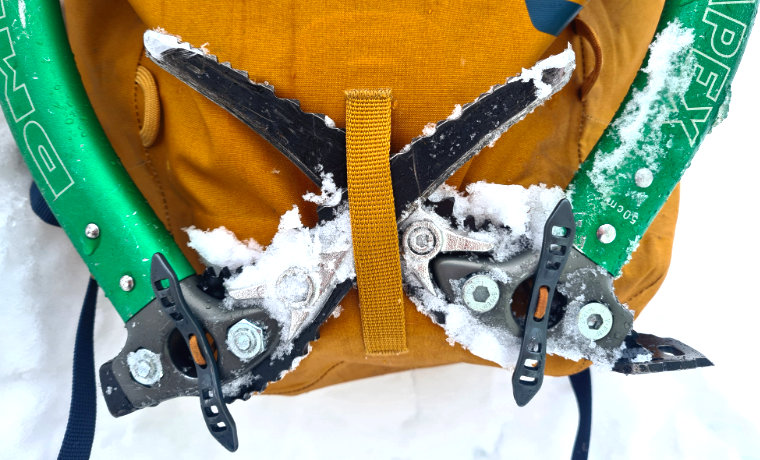 This is by far the best system I’ve used for attaching axes and walking poles. Velcro straps for attachment points make it very quick and easy. The design is simple but it works so well, even if you’ve got thick gloves on in the winter. It keeps the points of your axes close to the backpack wall near the bottom, and keeps those sharp pointy ends tucked away safely. The only downside is when you have axes or poles attached, it makes it really difficult to access the zip pocket at the front of the pack. Surprisingly awkward, especially with a fully loaded backpack, the axes press against the storm flap of the zip, which you then can’t access.
This is by far the best system I’ve used for attaching axes and walking poles. Velcro straps for attachment points make it very quick and easy. The design is simple but it works so well, even if you’ve got thick gloves on in the winter. It keeps the points of your axes close to the backpack wall near the bottom, and keeps those sharp pointy ends tucked away safely. The only downside is when you have axes or poles attached, it makes it really difficult to access the zip pocket at the front of the pack. Surprisingly awkward, especially with a fully loaded backpack, the axes press against the storm flap of the zip, which you then can’t access.
Attachment loops
 The attachment loops for securing your helmet to the pack are small, functional, and easy to use. I find that everytime I put my pack down, the pack rolls onto my helmet attached to the front. Easy to damage a helmet by just putting your pack down, especially with modern, lightweight foam helmets.
The attachment loops for securing your helmet to the pack are small, functional, and easy to use. I find that everytime I put my pack down, the pack rolls onto my helmet attached to the front. Easy to damage a helmet by just putting your pack down, especially with modern, lightweight foam helmets.
There’s no straps on the side, which I mostly agree on for a climbing pack, except if you’re approaching your route on skis; there’s no option for ski attachment while climbing. Deuters’ argument here is that you buy a ski specific mountaineering pack. But if you’re into all mountain climbing related sports, should you have to buy a pack for every mountain discipline?
Front pocket
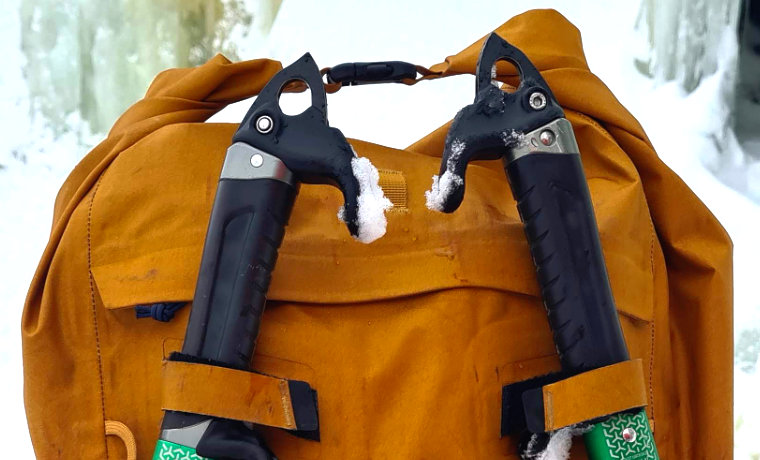 Like I mentioned before, one of the main drawbacks of the pack is its access to the pocket. It’s restricted and very awkward when you’ve got axes or poles attached. Apart from that, the front pocket is a great feature. It’s deep enough to have everything you need in it. The zip is water tight, and the storm flap works really well as the material is stiff enough to keep the zip covered all the time. It doesn’t actually flap! The front pocket spans the width of the pack, so it’s got plenty of room and depth, large enough to stow anything from keys to maps.
Like I mentioned before, one of the main drawbacks of the pack is its access to the pocket. It’s restricted and very awkward when you’ve got axes or poles attached. Apart from that, the front pocket is a great feature. It’s deep enough to have everything you need in it. The zip is water tight, and the storm flap works really well as the material is stiff enough to keep the zip covered all the time. It doesn’t actually flap! The front pocket spans the width of the pack, so it’s got plenty of room and depth, large enough to stow anything from keys to maps.
Internal pocket
 The only internal pocket is the back foam compartment. It’s deep enough to loose small bits stowed away and it takes a full arms length of fishing to find them again. This makes it near impossible if you have plenty of kit stuffed in the pack already. Like with most removable back support systems, they are awkward to fit back in once it’s removed. I don’t use this pocket for those reasons.
The only internal pocket is the back foam compartment. It’s deep enough to loose small bits stowed away and it takes a full arms length of fishing to find them again. This makes it near impossible if you have plenty of kit stuffed in the pack already. Like with most removable back support systems, they are awkward to fit back in once it’s removed. I don’t use this pocket for those reasons.
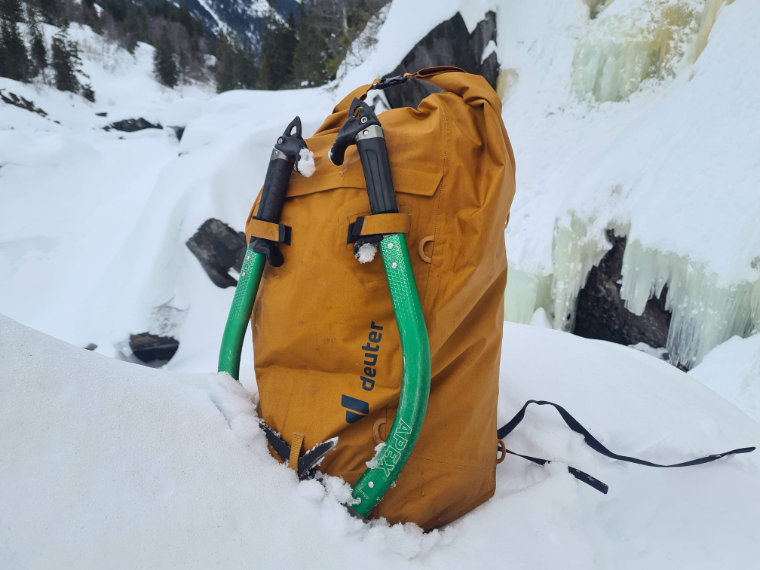
Deuter Durascent 30 Backpack review
I’ve had a great time using the Durascent over the last few months. It’s an absolute pleasure to use a pack that has had so much engineering, thought, and experience put into its design. This pack is built for one purpose, and that’s with mountaineering and climbing in mind. It’s not a versatile pack, and rightly so. With versatility of design and function, comes a drop in performance.
What really sets Deuter apart from its competitors is their attention to detail with the product user in mind. You can tell they’ve gone through great lengths of testing, and building on years of experience of trial and error to make something very functional.
You could point out several features that this pack doesn’t have, but that’s not what it’s built for. The Durascent is built for mountain performance on rock or ice, and each feature on the pack has a purpose and important function. It’s stripped of all the unnecessary extra straps/buckles and gadgets, and provides just enough to do its job, while keeping things light and simple. My friend Barry cut off all the excess straps, bucklets and dangley bits of his brand new Deuter climbing pack in 2008. It was so ridiculous at the time, but actually, it reminds me of the Durascent in terms of minimalism. A pioneer of backpack design with a kitchen knife!
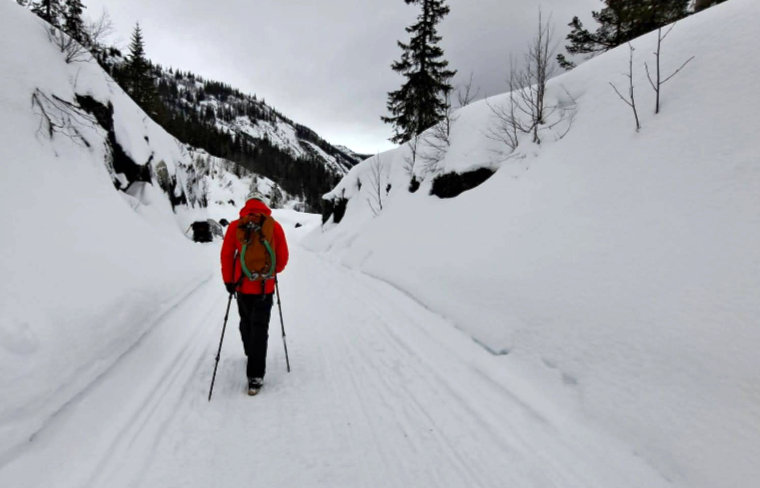
One thing I haven’t mentioned yet is the magic material this pack is constructed from. Deuter has used 220D Polyamide throughout. It’s a highly waterproof, tear resistant material, which is accompanied with wielded and taped seams, and is TPU coated. This is my favorite feature of this backpack, and it really does keep your kit dry from spindrift, snow, and Welsh rain. Unfortunately using this material can often be a double edged blade, as it’s easy to put a hole through with a crampon, an axe, or a pole. Something which I’ve done too many times to backpacks. The fragility of the material is certainly one of the major drawbacks. I had wear and tear at the bottom of my pack only after a month or two of use.
It’s clearly evident they’ve evolved the material they’ve used from previous climbing backpacks. I remember my first Deuter climbing pack from 2009, which was close to 2kg. The Durascent weighs just above 700g! An issue they’ve really worked hard to address over the years of development and pack evolution.
Like with most Deuter kit, they use DWR finishes for waterproofing, which is environmentally friendly and harmless to humans and animals. A must have feature these days in terms of sustainability with outdoor gear production.
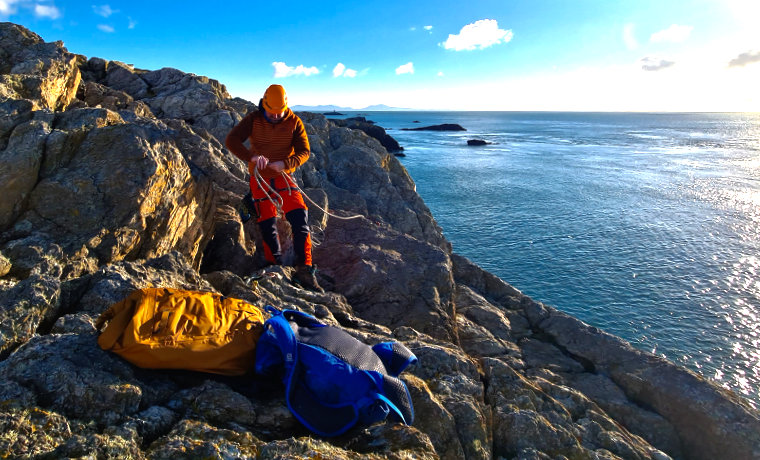
What I love the most about the Deuter Durascent 30 Backpack
The gold star from me with the Durascent is that it’s waterproof. I’ve longed for a waterproof mountaineering pack for years, and Deuter has heard my call. I spend countless days in the mountains every year for work and play, and I’m so tired of drying out soggy kit everytime I come back home. Everything in this bag stays dry.
I’ve never used a backpack that was all white on the inside. The material is also slightly translucent, allowing some light to pass through into the pack. This actually makes a remarkable difference when fishing for kit from the depths of the pack, as it’s bright enough inside to see everything from bottom to top.
The axe and pole attachment system is superb. Easy to use with gloves on, and it’s super quick.
What I don’t love so much about the Deuter Durascent 30 Backpack
The shoulder strap tails are unnecessarily long. I’ve been hit in the eyes and face on windy days, which is not what you want when you’re mid move on a crux pitch of a winter route or a balancy mountain scramble.
The front pocket isn’t much use when you’ve got your pack full and axes attached to the front. You have to take off your axes or poles to access the pocket.
After searching high and low for the helmet attachment net in the bag, I learned that it’s not actually included, and you have to purchase it separately. If you’ve just paid €210 for a 30L pack, you’d expect it would be included!
The pack doesn’t have any side straps, which can be useful at times in the mountains. However, its lack of versatility does make up for it as a climbing pack, which is what it’s built for.
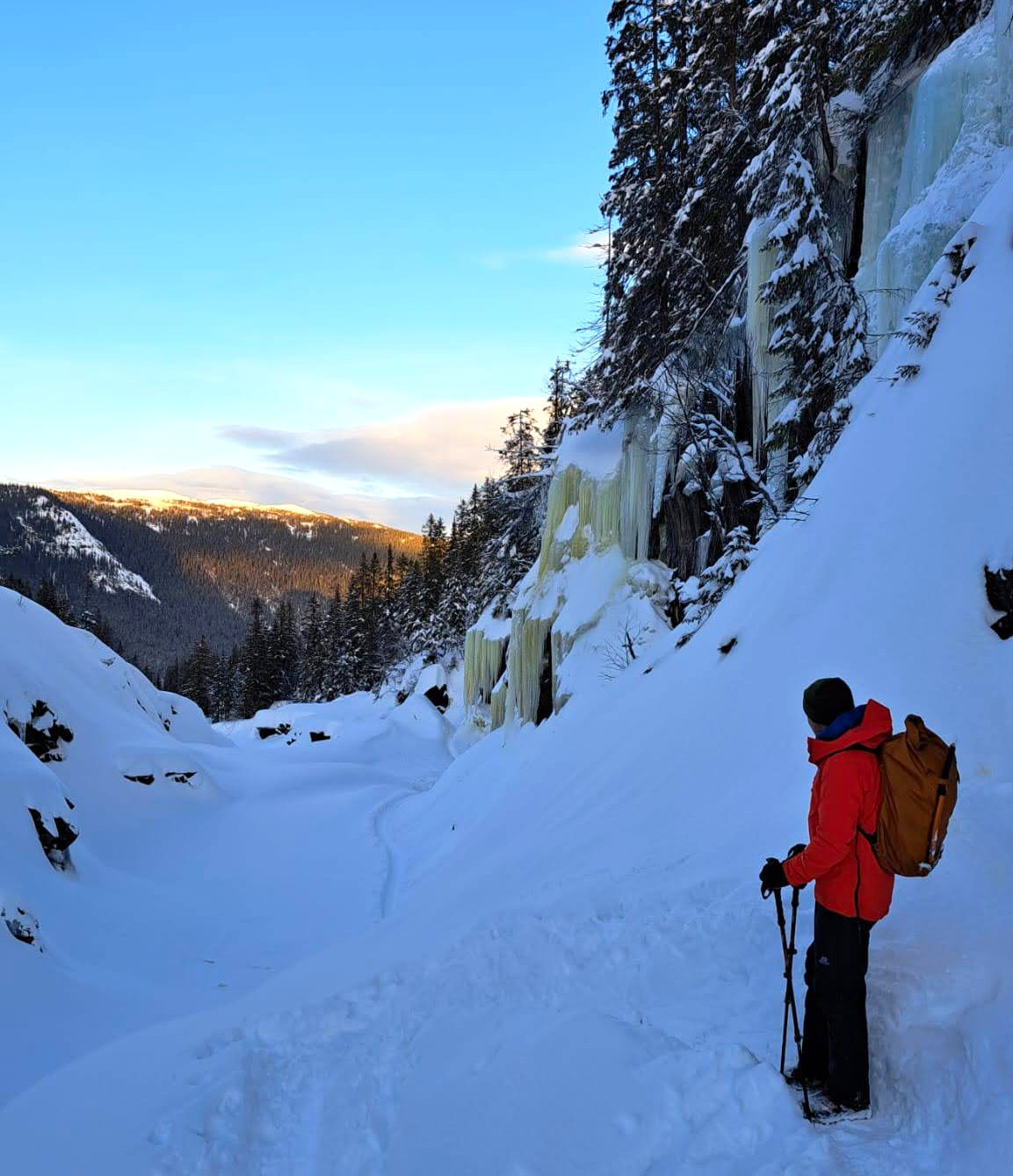
Verdict
Despite my bickering, I love this backpack. For mountaineering and climbing, it’s the best technical pack I’ve used to date. You can clearly tell it’s been born from decades of design and construction experience from Deuter. It’s been refined from generations of alpine pack development, for mountaineers and climbers in mind. Despite the delicate feel to the material, it’s a performance pack, for performing in the mountains on snow, rock, or ice. It does exactly what it says on the tin, for those in mind.
The Durascent retails at €210 on the Deuter website. It’s a staggering amount to pay for any pack. But if you are serious about climbing mountains, you can probably justify the price. It might not last as long as the older, heavier and more robust packs, but you certainly won’t be disappointed in performance. 5 out of 5 stars for me.
Find the latest price at:
Deuter
Looking for something less specific to mountianeering and more suitable to general mountain and winter conditions? Check out the Deuter Freescape Pro 40 Backpack.
Disclaimer: Cool of the Wild received this product free in return for an honest review. We only recommend gear that we love from companies we trust and we are under no obligation to give a positive review. All thoughts and opinions are that of the reviewer and we are in no way influenced by the brand or company.
The post Review: Deuter Durascent 30 Backpack appeared first on Cool of the Wild.


